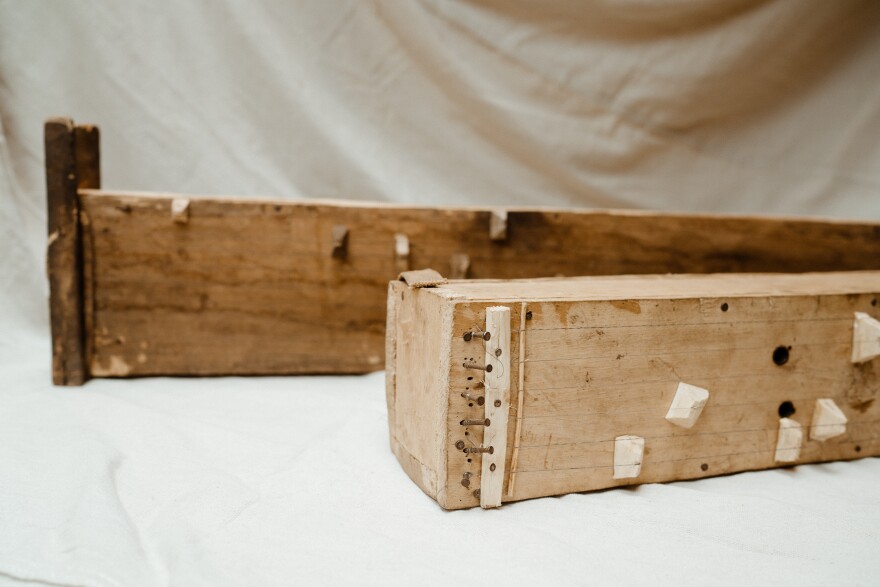The Missouri Botanical Garden offers striking views no matter the season. Now, patrons are being asked to notice the sounds it has to offer, too.
The garden’s new exhibition, “Botanical Resonance: Plants and Sounds in the Garden,” exists where art and science intersect — and each detail is informed by something sonic. It opened on Friday at the Stephen and Peter Sachs Museum.
Its curator, Nezka Pfeifer, told St. Louis On The Air that her inspiration for “Botanical Resonance” came from her introduction to sound walks — a type of sound art that invites participants to deeply engage with the sounds around them as they walk through their environment.
Pfeifer and Kappner met in Amsterdam at an arts conference where Kappner led workshops about sound art and soundwalks.
“[Kappner] has so much training in shamanic studies, horticulture therapy and using plants as a way to connect to the earth,” Pfeifer said. “I was very lucky to participate in her guided meditations.”

Their conversations made Pfeifer curious about the relationship between plants and sound — and eventually her proposal for “Botanical Resonance” was approved by the Missouri Botanical Garden.
Pfeifer knew she wanted Kappner to design a sound walk for “Botanical Resonance” that would connect people to the plants in the garden.
“She has such an incredible ability to tie people into the space that [they’re] in,” Pfeifer said, “as well as have [them] focus [their] mind in other ways.”
Kappner designed her sound walks to work outside the museum. That vision became part of the indoor space curated by Pfeifer, who explained that visitors are encouraged to “move out and really understand and participate in [Kappner’s] unique skill of getting people to pay attention to where their consciousness is going, and to tie it to the land that’s around them.”
The majority of Pfeifer’s research explores the scientific and cultural relationship between plants and sound. The main exhibition space comprises detailed information, rare artifacts, specimens and instruments made out of plants. Some of the Western instruments that are included are Taylor guitars, woodwinds and a violin. The Missouri Botanical Garden also has connections with other countries — many of which are represented in the exhibition.
“[There are] several botanists here at the garden who all hail originally from South American countries,” said Pfeifer. “They note some of the musical cultures of their countries, and they very kindly shared some of the instruments that they have in their collection.”
Some endangered Missouri-based woods are also included in the exhibition. “Chinquapin is a native Missouri chestnut species,” Pfeifer said. “They have fungal blight that has weakened the entire population throughout Missouri and other parts of the Ozarks.” The Ozark Chinquapin Foundation is working to strengthen the species.
“As a tree that was found and used by indigenous peoples and then later colonial settlers,” Pfeifer said, “this tree was used for [many] purposes.” One use was the crafting of musical instruments, which the exhibition has some examples of.
On the other side of the globe, the Missouri Botanical Garden maintains research teams in Madagascar as part of a long-standing ecological conservation program. Botanists from the Precious Woods Project in Madagascar helped bring other instruments into the exhibition, including those derived from ebony and rosewoods native to the country.
Additional instruments from Madagascar came from the William L. Brown Center ethnobotany collection.. One of Pfeifer’s interns researched the valiha, a Magalasy tube zither, and through their research found other instruments that were ultimately included in the exhibition. “Even though the [precious] woods today are not being used to make instruments,” Pfeifer said, “other plants in Madagascar are.”

As a result of Madagascar’s complex colonial history, many of its instruments resemble Western instruments such as guitars and violins. “The way that they’re played is much more in tune with the musical culture of the Middle East or Southeast Asia,” Pfeifer said. “The instrument may not create the sounds that we would assume [it] to.”
The connection between the forest and sound goes beyond human-made instruments. Research about how insects use plants as a means of communication is included in the exhibition as well. The research was conducted by Dr. Kasey Fowler-Finn, a St. Louis University biologist.
“[The] plants have [also] been recorded,” Pfeifer said. “If they can sense through vibration, which is how a lot of plants understand sound, that there's a pollinator nearby, they may actually start increasing their nectar production. Because that will attract the pollinator to come pick up the pollen, and then go out and continue the cross fertilization of that species of plants. We ourselves do not have the senses by which to understand what that sound is.”
Related Event
What: “Botanical Resonance: Plants and Sounds in the Garden”
When: June 2022-March 2023
Where: Missouri Botanical Garden, 4344 Shaw Blvd., St. Louis, MO 63110
“St. Louis on the Air” brings you the stories of St. Louis and the people who live, work and create in our region. The show is hosted by Sarah Fenske and produced by Emily Woodbury, Kayla Drake, Danny Wicentowski and Alex Heuer. Avery Rogers is our production assistant. The audio engineer is Aaron Doerr.






